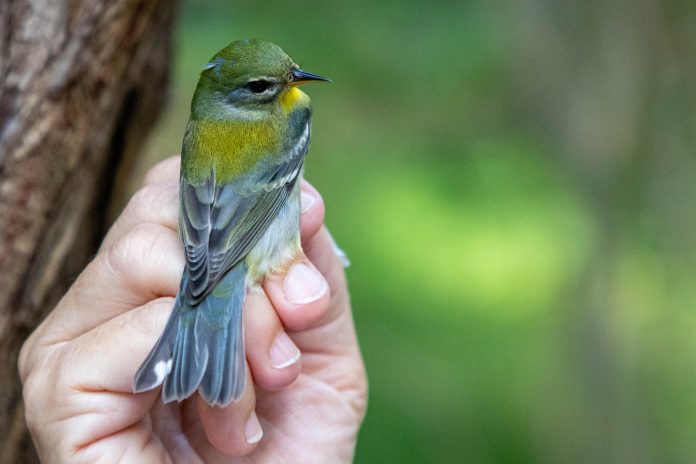|
Getting your Trinity Audio player ready...
|
South Floridians can support crucial migratory bird research and help educate the next generation of local conservationists by donating to “Adopt-A-Net,” a Fall Migration fundraising campaign to benefit the Cape Florida Banding Station (CFBS). The field research conducted by CFBS staff and a team of trained volunteers illuminates the importance of protecting native habitat for migrating songbirds, especially within Miami-Dade County’s urban core. The 2023 “Adopt-A-Net” effort provides MDC residents with the opportunity to help replace worn “mist nets” and fund other needs that are integral to CFBS operations. The data gathered enables researchers to study bird migration patterns, range, lifespan and the impacts of Climate Change from season to season.
Thousands of songbirds stop at Bill Baggs Cape Florida State Park (BBCFSP) every Spring and Fall to refuel as they migrate along the Atlantic Flyway, heading either for North American summering habitats or southern wintering destinations in Central and South America and the Caribbean. CFBS volunteer community scientists have been banding these neotropical migrants during their Fall Migration (mid-August through early November) since 2002. Tropical Audubon Society has been partnering with CFBS since 2020, which enabled station cofounder Michelle Davis to stage the first regular annual Spring Migration banding season in March of 2021.
Fall 2023 marks the promotion of volunteers Nasim Mahomar and Nicole Rita to the positions of co-coordinators overseeing the daily CFBS field operations.
“The goal is to help visiting birds survive and thrive,” says Tropical Audubon Society Senior Conservation Director Lauren Jonaitis. “Our seasonal visitors need to count on our region for food, shelter and fresh water, which can be hard to come by for migrating songbirds, especially in Miami-Dade’s urban areas.”
Why Adopt-A-Net? Florida’s punishing sun weakens and damages the delicate, nylon mist nets needed to gently capture migrating birds for brief examination, documentation, banding and release. To help replace old, worn nets and other essential equipment, the inaugural “Adopt-A-Net” fundraiser was hatched in 2021.
Purchasing new nets is necessary to document Fall Migration, which runs from August 15 to November 10, with the help of field technicians and a dedicated group of volunteers. Anyone interested in helping researchers better understand the needs of birds on their migratory journeys can “adopt” one of the station’s 36-foot-long mist nets for $150, or fund a half-net stake for $75. Adopt-A-Net sponsors will receive a season-end report and photos highlighting which bird species were discovered in the donor’s “adopted” net, as well as a list of all the bird species banded at the station during the Fall Migration season. Custom signs displaying each sponsor’s name will distinguish “adopted” nets for the duration of the season.
Go Big! New this year, donors who contribute $500 will be thanked with a private tour of CFBS and also receive a print of an original work of art created by Michelle Davis — one of her distinctive 9×12” field sketch watercolors featuring a Cape Florida bird species. Donors who step up to the $2,000 level will receive an original watercolor painting.
Davis, who holds a PSM in Environmental Policy and Management from FIU and has a passion for field sketching, says, “Adopt-A-Net was designed to educate the public about the indispensable research we do at the station, while raising funds to support it.”
All Adopt-A-Net sponsors will be recognized on Tropical Audubon Society’s and CFBS’s websites, as well as on the CFBS Blog (sponsors also have the option to remain anonymous).
Support CFBS today! Click HERE to Adopt-A-Net Today!
CFBS Backgrounder:
Bird banding is the practice of capturing a bird, placing a uniquely numbered aluminum band around its leg, noting its age, health, sex, size and weight, and then releasing it. Banding enables a bird to then be identified if it is subsequently recaptured. Most importantly, banding enables researchers to study bird migration patterns, range, how long birds live and the impacts of Climate Change over time.
To safely capture migrating birds, 23 mist nets are set out at BBCFSP in an area covering approximately 8 acres within a restored hardwood hammock. The birds who fly into the nets are gently removed, banded and quickly released.
The data CFBS gathers helps scientists understand songbird migration patterns, and underscores the importance of the park’s restored native hardwood hammock to these migrants. Ideally located in one of the state’s most valuable Important Bird Areas (IBA) for migratory birds, the site yields crucial data that has been informing researchers, the public and civic leaders for more than two decades.
Since its 2002 founding, the CFBS has operated with a Federal Master banding permit, State banding permit and Park research permit, and has banded more than 45,000 birds representing 119 species, with an average of 1,900 birds banded each Fall. Neotropical migrant warblers, vireos, thrushes, buntings, catbirds and flycatchers make up the majority of the species banded.
Learn more:
Volunteer: Knowledgeable birders interested in potentially becoming a trained bander at CFBS can email Michelle Davis at capefloridabanding@tropicalaudubon.org
For more information about the Cape Florida Banding Station visit the Tropical Audubon Website or the CFBS Blog: https://capefloridabandingstation.wordpress.com/






